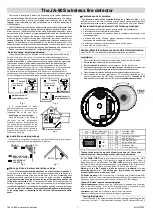
HEADER OPERATION – D SERIES
Form 169304
63
Model Year - 2009
6.4.2
Header Flotation
Float is intended for cutting crops that require
the cutterbar to be in contact with the ground.
Optimum float is for the cutterbar to maintain
contact with the ground with minimum bouncing
and scooping or pushing soil.
The machine will perform best with minimum
extra weight on the header.
IMPORTANT
To avoid frequent breakage of sickle
components, scooping soil, or soil build-up
at cutterbar in wet conditions, header float
should be set as light as possible without
causing excessive bouncing. When float
setting is light, it may be necessary to use
a slower ground speed to avoid excessive
bouncing and leaving a ragged cut.
IMPORTANT
The stabilizer wheels are designed to
minimize bouncing at the header ends and
not “float” the header. Refer to the D60
Harvest Header / FD70 FlexDraper
Operator’s Manual for adjustment details.
6.4.2.1 Float Operating Guidelines
When working with the cutterbar on the ground;
•
Set center link to mid-range position. Refer
to Section 6.4.4 Header Angle.
•
In rocky fields, adjust skid shoes down to
raise guards when operating at flattest
header angle to minimize scooping rocks.
•
Adjust header height or adjust header angle
to minimize pushing soil.
6.4.2.2 Float Adjustment
The float adjustment uses drawbolts to change
the tension on the springs in the lift linkages.
a. Check header float as follows:
CAUTION
Check to be sure all bystanders have cleared
the area.
1. Start the engine.
2. If hydraulic center link is installed, use the
HEADER TILT SWITCHES to set center link
to mid-range position (05.0 on CDM) (A).
3. Using HEADER DOWN switch, lower
header fully with lift cylinders fully retracted.
DANGER
Stop engine and remove key from ignition
before leaving operator's seat for any
reason. A child or even a pet could engage
an idling machine.
4. Shut down engine and remove key.
5. Grasp the divider rod and lift. The force to
lift should be as noted in the following table,
and should be approximately the same at
both ends.
(continued next page)
HEADER DOWN
HEADER
TILT UP
HEADER
TILT DOWN
A
















































